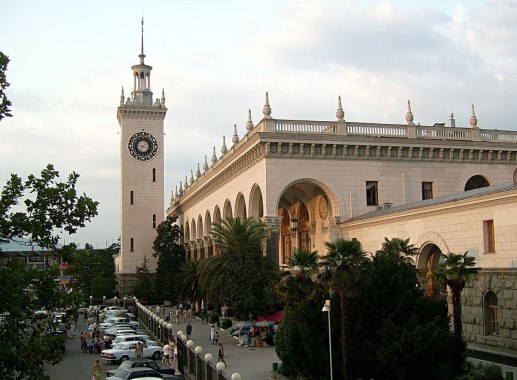Information
Tournament Format
The 10 teams are divided into two, five-team groups in the Preliminary Round.
After a single round-robin series in each group, the top four teams from each group advance to the Playoff Round while the fifth-placed team in each group moves to the Relegation Round.
The top four placed teams from the Preliminary will play a cross-over Quarter-final game: 1A vs. 4B, 1B vs. 4A, 2A vs. 3B and 2B vs. 3A. The winner of each Quarter-final moves onto the Semi-Finals.
The winner of each Semi-Final game will move onto the Gold Medal Game, while the losers will play in the Bronze Medal Game.
Relegation format
The two last-placed teams play a best-of-three Relegation Round series. The third game is only played if needed. The winner of the series plays again at the 2014 IIHF Ice Hockey U18 World Championship, while loser is relegated to Division I Group A.
Three Point System
For all games points shall be awarded as follows:
- 3 points for the winning team at the conclusion of regulation time
- 1 point for both teams at the conclusion of regulation time if the game is tied
- An additional point earned for the team winning the game in a 5-minute overtime period, or the Game Winning Shots Procedure if the teams are still tied following conclusion of the overtime period
- 0 points for the team losing the game in regulation time
Overtime Operations
If a game is tied at the end of regulation time, a five-minute overtime period shall be played immediately after an intermission of three minutes. The teams will defend the same goals as in the third period. The game will end when the five minutes has expired or when a goal is scored; the scoring team will be declared the winner. If no goal is scored in the overtime period then the Game Winning Shots Procedure will apply. All overtime periods of any IIHF game shall be played with each team at the numerical strength of four (4) skaters and one (1) goalkeeper.
Overtime procedure in Play-Off Games:
- In case of a tie at the conclusion of regulation time in a Quarter Final, Semi Final and Bronze Medal Game, there will be a 10-minute sudden-death overtime period played, following a three-minute intermission.
- The teams will defend the same goals as in the third period.
- The team, which scores a goal during this period is the winner.
- In the Gold Medal game there will be a 20-minute sudden-death overtime period, following a 15-minute intermission during which the ice will be resurfaced.
- The teams will change ends.
- The team which scores a goal during this period is declared winner.
- If no goal is scored during the sudden-death overtime, there will be Game Winning Shot (GWS) competition ("shootout") according to the Game Winning Shots Procedure.
Game Winning Shots Procedure
If no goal is scored in the overtime period then the Game Winning Shots (GWS) procedure will apply. The following procedure will be utilized:
- Three different shooters from each team will take alternate shots, until a decisive goal is scored.
- If the game is still tied after three shots by each team, the GWS will continue with a tie-break shoot out by one player of each team, with a reversed shooting order.
- The same or new players can take the tie-break shots. The same player can also be used for each shot by a team in the tie-break shoot-out.
- Only the decisive goal will count in the result of the game.
- Shots will be taken at both ends of the ice. The area of the ice to be used will be dry scraped.
- A coin toss will determine which team takes the first shot, with the winner of the toss having the choice whether his team will shoot first or second.
- Any player whose penalty was not over when overtime ended cannot take the shots and must stay in the penalty box or in the dressing room.
- Once named, players may only be replaced in the event of injury or penalty.
- The substitute stand-by player is placed last in the shooting order.
- The goalkeepers will defend the same goal, as determined by the Referee.
- The goalkeepers from each team may be changed after each shot.
- The players of both teams will take the shots alternately until a decisive goal is scored.
- The decisive goal will be credited to the player who scored and to the goalkeeper concerned.
Tie breaking formula
The tie-breaking system for two teams with the same number of points in a standing will be the game between the two teams, the winner of the game taking precedence.
Due to the fact that the three-point system does not allow a game to end in a tie, then the following tie breaking procedure is applicable when three or more teams are tied in points in a Championship standing.
Should three or more teams be tied on points, then a tie breaking formula will be applied as follows, creating a sub-group amongst the tied teams. This process will continue until only two or none of the teams remain tied. In the case of two tied teams remaining, the game between the two would then be the determining tie-breaker as the game could not end as a tie. In the case of none of the teams being tied, the criteria specified in the respective step applies.
Step 1:
Taking into consideration the games between each of the tied teams, a sub-group is created applying the points awarded in the direct games amongst the tied teams from which the teams are then ranked accordingly.
Step 2:
Should three or more teams still remain tied in points then the better goal difference in the direct games amongst the tied teams will be decisive.
Step 3:
Should three or more teams still remain tied in points and goal difference then the highest number of goals scored by these teams in their direct games will be decisive
Step 4:
Should three or more teams still remain tied in points, goal difference and goals scored then the results between each of the three teams and the closest best-ranked team outside the sub-group will be applied. In this case the tied team with the best result (1. points, 2. goal difference, 3. more goals scored) against the closest best ranked-team will take precedence
Step 5:
Should the teams still remain tied, then the results between each of the three teams and the next highest best-ranked team outside the sub-group will be applied.
Step 6:
Should the teams still remain tied after these five steps have been exercised then Sport considerations will be applied and the teams will be ranked by their positions coming into the Championship (seeding).
Note: If not all mutual games have been played yet in an ongoing tournament, the tied teams will be ranked in the standings according to the following criteria: 1. Lower number of games played, 2. Goal difference, 3. Goals scored, 4. Positions coming into the Championship.
More information
Click here to download the IIHF’s Rule Book and Sport Regulations.
Venues
«Bolshoy» Ice Dome and «Shayba» Arena is a part of the Ice Hockey Complex, which consist also Hockey Training Venue.
«Bolshoy» Ice Dome
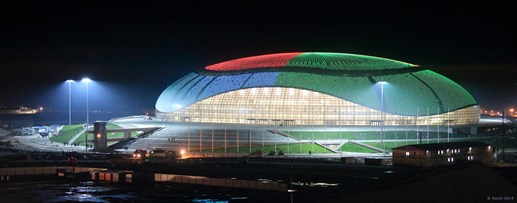
On the one hand, name of this venue emphasizes peculiarities of the construction. «Bolshoy» will become one of the most spacious sport venues, built for holding competitions in the most popular sports. At the same time the word «bolshoy» has become and understandable and recognizable term among many countries and nations that associates with Russia, and in particular with the «Bolshoy» theater and with traditions of Russian ballet, figure skating, hockey and other achievements of the largest country in the world.

- «Bolshoy» Ice Dome is a competition venue of a permanent type.
- Gross capacity — 12000 seats
- Total area — 96115 sq. m
- Building height — 40.3 m
- «Bolshoy» Ice Dome has 7 levels. Three of them are considered as underground levels because of their location under the stylobate area.
«Shayba» Arena
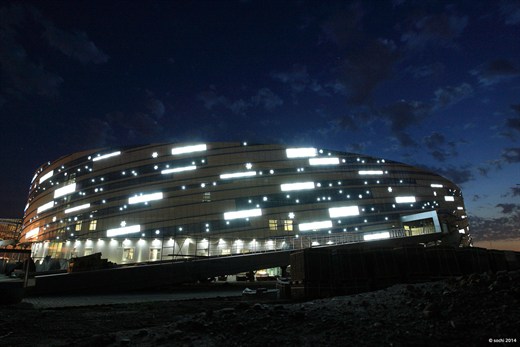
«Shayba» means «puck» in Russian. It is a sport equipment that the absence of which it is impossible to imagine the game of hockey. The name of the venue fully reflects its purpose. Moreover, for Russians the shout «Shaybu!» as encouragement to score a goal is a universal and recognizable way to support their national team on international competitions.
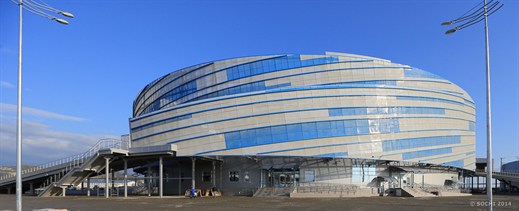
- «Shayba» Arena is a competition venue of a dismountable type.
- «Shayba» Arena can be dismantled and rebuilt for post-Olympic use as a hockey arena in any other city of Russian Federation
- Gross capacity — 7000 seats
- Building height — 22.8 m
- «Shayba» Arena consists of 4 levels (1 undeground level and 3 overground).
Ticket Information
The Championship will take place at the "Bolshoy" Ice Dome and the "Shayba" Arena, both of which are situated in the Olympic Park (Sochi).
Ticket Prices
Ticket prices vary depending on the session of the Championship and do not depend on Sport venues.
| Session | Category I | Category II | Club level (Bolshoy) | Skyboxes |
| Preliminary | 200 RUB/day | 100 RUB/day | n/a | Upon request |
| 1/4 final | 200 RUB/day | 100 RUB/day | 300 RUB/day | Upon request |
| 1/2 finnal | 200 RUB/game | 100 RUB/game | 300 RUB/game | Upon request |
| Bronze | 200 RUB/game | 100 RUB/game | 300 RUB/game | Upon request |
| Final | 400 RUB/game | 200 RUB/game | 600 RUB/game | Upon request |
For the preliminary round and quarter-finals, spectators will be able to buy a single ticket to all the sessions taking place at a specific venue on that day of competition. For the semi-finals, bronze medal game and gold medal game, spectators will be able to buy separate tickets to each session, including the consolation matches taking place on April 26 and 28.
Sales
Online: on this website or www.parter.ru, www.kontramarka.ru
Ticket Offices:
Moscow: 1 Bolshaya Dmitrovka Street
Sochi: 6 Vorovsky Street and 50 Kirov Street (Adler)
The ticket office situated in the Olympic Park, located in front of the security perimeter around the ice arenas, which will operate between April 17 and 28, 2013.
A full list of the ticket offices is available here. http://www.parter.ru/ru/kassy/ (in Russian)
Call-center (information about the sports events, and booking) +7 (495) 2580000; +7(495) 9333200
How to get tickets
Purchasing tickets online:
This service is available for on-line ticket order and allows payments via credit card or electronic payment system.
- Register at the Ticket partner's website system(surname, first name, middle name, data of your ID);
- Choose your seat and ticket price category;
- Choose a ticket office where you can pick up your Ticket;
- Pay for your order;
- Print your Voucher;
- Go to the ticket office you selected in step No. 3, present your ID and exchange your Voucher for a Ticket.
Purchasing tickets at the ticket offices:
- Select your seat and Ticket price category;
- Pay for your order in cash or by credit card;
- Receive your Ticket.
Booking tickets via the call-center:
- Place your order with the call-center operator;
- Select your seat and Ticket price category;
- Receive a Booking number that is valid for 48 hours;
- Pay for your ticket at the ticket office selected when making the booking.
Spectator Access
Spectators will enter and exit the territory of the venues via the checkpoint of the Olympic Park in Sochi.
To gain access to the sports events, spectators must have a valid ticket and a Spectator Pass.
You can find all the information you need about the Spectator Pass, and how to obtain one, on the website www.reg.sochisportevents.com.
By purchasing tickets, Spectators are confirming that they are willing to abide by the Rules of attendance at the venues, and that they have familiarized themselves with the list of prohibited items and items for which restrictions apply. The rules of attendance, and a complete list of the aforementioned items, can be found on the website www.sochisportevents.com. Spectators may be refused entry to the event on grounds of security, without having the reasons explained to them.
Download
Sochi & Krasnodar
The incredible Krasnodar region
The Krasnodar region is the southernmost region of Russia, with an area of 76,000 square kilometres. It borders the Rostov region in the north-east, the Stavropol region in the east and Abkhazia in the south. In the north-west and south-west the region borders the Sea of Azov and the Black Sea. The region's border is 1,540 km long in total, being 800 km inland and 740 km along the coast. At its longest point, the Krasnodar region is 327 km from north to south and 360 km from west to east. More than five million people live here.
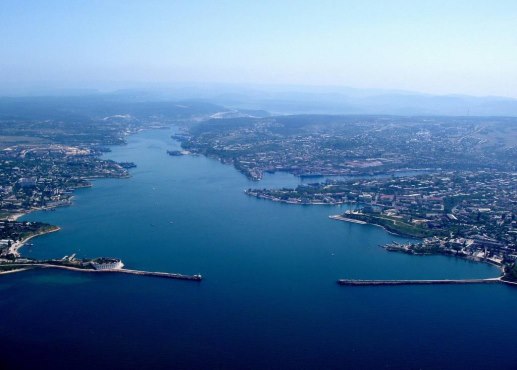
The unique natural and climatic conditions of the Krasnodar region (combining moderate continental and subtropical climates) make it the most popular tourist resort area in Russia and practically the only coastal balneotherapy and recreational resort centre in the country.
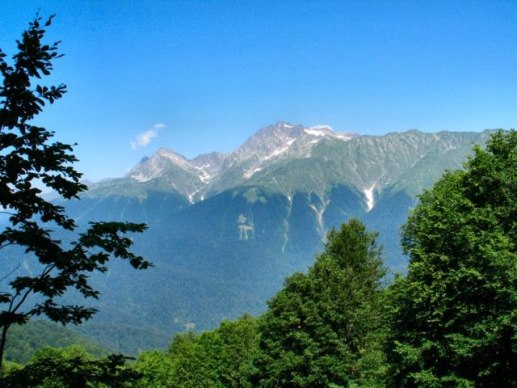
Krasnodar means “beautiful gift”, and the region is indeed a gift to the world to enjoy for the Winter Games in 2014 and beyond. Headed by the vibrant city of Sochi, Krasnodar is a pioneering region which in many ways epitomizes modern Russia, reflecting its core values, economic stability and growth.
Hospitable Sochi
Vibrant, beautiful, exciting, multi-cultural Sochi is an unforgettable city which captures the very essence of a modern nation and is the ideal location for Russia’s first ever Olympic and Paralympic Winter Games.
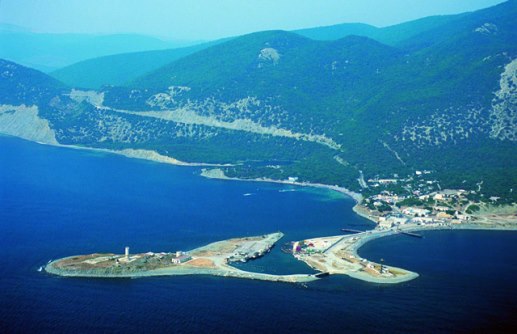
Sochi is the largest resort city in Russia, situated between the Black Sea and the Caucasus mountains with a subtropical climate on the coast yet only 40 km from the alpine climate of the breath-taking peaks of Krasnaya Polyana. Average temperatures: summer +26°С, winter +6°С.
Sochi is on the same altitude as Nice, Toronto and Vladivostok and, at 145 km, is thought to be the longest city in Europe. The city’s attractive coastline, known as the Russian Riviera, has already helped Sochi to become one of Russia’s top resort destinations. Sochi attracts from 3.5 to 4 million tourists and holidaymakers each year.
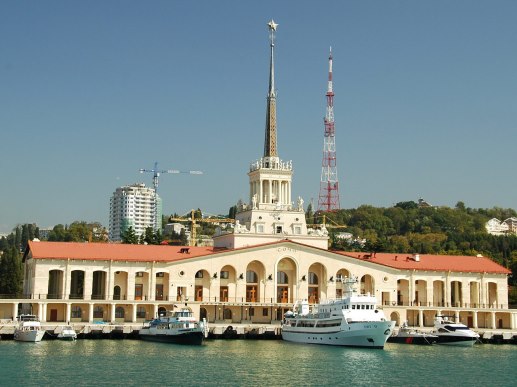
The city is divided into four administrative districts: Central, Hostinsky, Adlersky and Lazarevskoye where many hotels and camp sites are situated. The city’s architectural complex was designed by some of the best Soviet architects of 1930-1950.
Sochi is a city of 400,000 people from over 100 different nationalities and provides a model of harmonious urban life. The city is accessible by plane, ferry, train and car. Airlines provide scheduled and charter flights from Sochi's new international airport. The airport's route network covers more than 60 national and international destinations. There are also direct ferry links from Sochi to Turkey, Greece and Ukraine.
As Sochi prepares for the 2014 Olympic and Paralympic Winter Games, the city is set to share its wonders with the world. Its historic buildings, parks and beaches will be augmented by some of the world’s finest sports facilities, making the city and its mountainous surrounds a regional and global centre for sport throughout the year, to welcome and be accessible to all.
History
The IIHF Ice Hockey U18 World Championship is an annual event organized by the International Ice Hockey Federation for national U18 ice hockey teams from around the world. The tournament is usually played in April.
Results
|
Year |
Gold |
Silver |
Bronze |
Venue |
|
1999 |
Finland |
Sweden |
Slovakia |
Füssen / Kaufbeuren (Germany) |
|
2000 |
Finland |
Russia |
Sweden |
Kloten / Weinfelden (Switzerland) |
|
2001 |
Russia |
Switzerland |
Finland |
Heinola / Helsinki / Lahti (Finland) |
|
2002 |
United States |
Russia |
Czech Republic |
Piestany / Trnava (Slovakia) |
|
2003 |
Canada |
Slovakia |
Russia |
Yaroslavl (Russia) |
|
2004 |
Russia |
United States |
Czech Republic |
Minsk (Belarus) |
|
2005 |
United States |
Canada |
Sweden |
Ceske Budejovice / Plzen (Czech Republic) |
|
2006 |
United States |
Finland |
Czech Republic |
Angelholm / Halmstad (Sweden) |
|
2007 |
Russia |
United States |
Sweden |
Tampere / Rauma (Finland) |
|
2008 |
Canada |
Russia |
United States |
Kazan (Russia) |
|
2009 |
United States |
Russia |
Finland |
Fargo (USA) |
|
2010 |
United States |
Sweden |
Finland |
Minsk / Bobruisk (Belarus) |
|
2011 |
United States |
Sweden |
Russia |
Crimmitschau / Dresden (Germany) |
|
2012 |
United States |
Sweden |
Canada |
Brno / Znojmo (Czech Republic) |
|
2013 |
Sochi (Russia) |
Medal Count
|
No. |
Country |
Gold |
Silver |
Bronze |
Total |
|
1 |
United States |
7 |
2 |
1 |
10 |
|
2 |
Russia |
3 |
4 |
2 |
9 |
|
3 |
Finland |
2 |
1 |
3 |
6 |
|
4 |
Canada |
2 |
1 |
1 |
4 |
|
5 |
Sweden |
0 |
4 |
3 |
7 |
|
6 |
Slovakia |
0 |
1 |
1 |
2 |
|
7 |
Switzerland |
0 |
1 |
0 |
1 |
|
8 |
Czech Republic |
0 |
0 |
3 |
3 |
Eligibility
To play in the IIHF World Championship, the Olympic ice hockey tournament and the qualifications to these competitions, players must fulfill the following qualification requirements:
- Each player must be under the jurisdiction of an IIHF member national association
- Each player must be a citizen of the country he represents.
Acquiring a new national eligibility (The ‘two-year’ case)
When a player has changed his citizenship or has acquired another citizenship and wants to participate for the first time in an IIHF competition representing his new country he must:
- Prove that he has participated for at least two consecutive years in the national competitions of his new country during which period he has neither transferred to another country nor played ice hockey within any other country.
- Have an international transfer card (ITC) that shows the transfer to the national competition of his new country and which was approved and dated at least two years before the start of the IIHF competition in which he wishes to participate.
Change of national eligibility (The ‘four-year’ case)
A player, who has previously participated in IIHF competition, can switch national eligibility (but only once in a player's life) if:
- He is a citizen of the new country of his choice.
- He has participated for at least four consecutive years in the national competitions of his new country, during which period he has neither transferred to another country nor played ice hockey within any other country and has not played for his previous country in an IIHF competition during this four year period.
- He has an international transfer card (ITC) that shows the transfer to the national competition of his new country and which was approved and dated at least four years before the start of the IIHF competition in which he wishes to participate.

















































